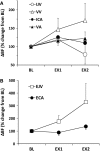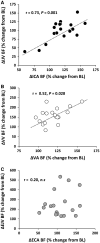Relationship between cerebral arterial inflow and venous outflow during dynamic supine exercise
- PMID: 28663325
- PMCID: PMC5492200
- DOI: 10.14814/phy2.13292
Relationship between cerebral arterial inflow and venous outflow during dynamic supine exercise
Abstract
The regulation of cerebral venous outflow during exercise has not been studied systematically. To identify relations between cerebral arterial inflow and venous outflow, we assessed the blood flow (BF) of the cerebral arteries (internal carotid artery: ICA and vertebral artery: VA) and veins (internal jugular vein: IJV and vertebral vein: VV) during dynamic exercise using ultrasonography. Nine subjects performed a cycling exercise in supine position at a light and moderate workload. Similar to the ICA BF, the IJV BF increased from baseline during light exercise (P < 0.05). However, the IJV BF decreased below baseline levels during moderate exercise, whereas the ICA BF returned near resting levels. In contrast, BF of the VA and VV increased with the workload (P < 0.05). The change in the ICA or VA BF from baseline to exercise was significantly correlated with the change in the IJV (r = 0.73, P = 0.001) or VV BF (r = 0.52, P = 0.028), respectively. These findings suggest that dynamic supine exercise modifies the cerebral venous outflow, and there is coupling between regulations of arterial inflow and venous outflow in both anterior and posterior cerebral circulation. However, it remains unclear whether changes in cerebral venous outflow influence on the regulation of cerebral arterial inflow during exercise.
Keywords: Cerebral blood flow; dynamic exercise; internal jugular vein; vertebral vein.
© 2017 The Authors. Physiological Reports published by Wiley Periodicals, Inc. on behalf of The Physiological Society and the American Physiological Society.
Figures



Similar articles
-
Coupling between arterial and venous cerebral blood flow during postural change.Am J Physiol Regul Integr Comp Physiol. 2016 Dec 1;311(6):R1255-R1261. doi: 10.1152/ajpregu.00325.2016. Epub 2016 Nov 2. Am J Physiol Regul Integr Comp Physiol. 2016. PMID: 27806982
-
Effect of jump exercise training on long-term head-down bed rest-induced cerebral blood flow responses in arteries and veins.Exp Physiol. 2021 Jul;106(7):1549-1558. doi: 10.1113/EP089102. Epub 2021 May 3. Exp Physiol. 2021. PMID: 33866619
-
Brain blood and cerebrospinal fluid flow dynamics during rhythmic handgrip exercise in young healthy men and women.J Physiol. 2021 Mar;599(6):1799-1813. doi: 10.1113/JP281063. Epub 2021 Feb 16. J Physiol. 2021. PMID: 33481257
-
The human craniospinal venous system and its influence on postural intracranial pressure: a review.J Neurosurg. 2024 Jul 19;141(6):1484-1493. doi: 10.3171/2024.4.JNS232254. Print 2024 Dec 1. J Neurosurg. 2024. PMID: 39029117 Review.
-
[The cerebral venous outflow tract].Ann Fr Anesth Reanim. 1998;17(2):144-8. doi: 10.1016/S0750-7658(98)80064-6. Ann Fr Anesth Reanim. 1998. PMID: 9750712 Review. French.
Cited by
-
The Effect of Submaximal Exercise on Jugular Venous Pulse Assessed by a Wearable Cervical Plethysmography System.Diagnostics (Basel). 2022 Oct 4;12(10):2407. doi: 10.3390/diagnostics12102407. Diagnostics (Basel). 2022. PMID: 36292096 Free PMC article.
-
Influence of head-up tile and lower body negative pressure on the internal jugular vein.Physiol Rep. 2022 May;10(10):e15248. doi: 10.14814/phy2.15248. Physiol Rep. 2022. PMID: 35581747 Free PMC article.
References
-
- Auer, L. M. , and Johansson B. B.. 1981. Cervical sympathetic nerve stimulation decreases intracranial pressure in the cat. Acta Physiol. Scand. 113:565–566. - PubMed
-
- Bain, A. R. , Smith K. J., Lewis N. C., Foster G. E., Wildfong K. W., Willie C. K., et al. 2013. Regional changes in brain blood flow during severe passive hyperthermia: effects of PaCO2 and extracranial blood flow. J. Appl. Physiol. 115:653–659. - PubMed
-
- Chung, C. P. , Lin Y. J., Chao A. C., Lin S. J., Chen Y. Y., Wang Y. J., et al. 2010. Jugular venous hemodynamic changes with aging. Ultrasound Med. Biol. 36:1776–1782. - PubMed
-
- Dawson, E. A. , Secher N. H., Dalsgaard M. K., Ogoh S., Yoshiga C. C., González‐Alonso J., et al. 2004. Standing up to the challenge of standing: a siphon does not support cerebral blood flow in humans. Am. J. Physiol. 287:R911–R914. - PubMed
MeSH terms
LinkOut - more resources
Full Text Sources
Other Literature Sources
Medical
Miscellaneous

